Environmental Tests are carried out to determine the resistance of sub-systems and systems to the natural environmental conditions, which they shall face through during their life cycles.
TUBITAK SAGE Environmental Test Laboratory is accredited by Turkish Accreditation Agency (TURKAK) according to TS EN ISO/IEC 17025 standard with respect to after mentioned tests. Accreditation scope and certificate of laboratory is accessible at www.turkak.org.tr.
Low Pressure (Altitude) Test is used to determine if materiel can withstand and/or operate in a low pressure environment and/or withstand rapid pressure changes. After installation of the test sample into the test chamber, it is exposed to low pressure by considering the real pressure conditions that the test sample will be exposed. Physical inspection and operational checkout of the test sample are performed during and/or after the test and any failure is recorded.
Tests can be conducted according to any military and civil standards which are appropriate with the test device’s technical specifications. Especially according to MIL-STD-810F/G Method 500, variety of tests was applied.
Technical Specifications:
Technical specifications of three different test chambers are given below;
Low Pressure Test Chamber - I
- Dimensions (H x W x D): 1000 mm x 1000 mm x 1500 mm
- Sample weight: 2000 kg max.
- Operating temperature range: -60°C to +100°C
- Humidity range: 20% to 80% Relative Humidity
- Operating pressure range: atmospheric pressure to 10 mbar
- Temperature accuracy: ±2°C
- Humidity accuracy: ±%5 relative humidity
- Pressure accuracy: ±%3
- Rapid decompression test capability (pressure drop from 752 mbar to 188 mbar in maximum 15 seconds)
Low Pressure Test Chamber - II
- Dimensions (H x W x D): 1000 mm x 1000 mm x 1000 mm
- Sample weight: 1000 kg max.
- Operating temperature range: -60°C to +100°C
- Humidity range: 20% to 80% Relative Humidity
- Operating pressure range: atmospheric pressure to 1 mbar
- Temperature accuracy: ±1°C
- Humidity accuracy: ±%5 relative humidity
- Pressure accuracy: ±%3
- Rapid decompression test capability (pressure drop from 752 mbar to 188 mbar in maximum 15 seconds)
Low Pressure Test Chamber – III (Not ready yet)
- Dimensions (H x W x D): 2000 mm x 2000 mm x 4500 mm
- Sample weight: 5000 kg max.
- Operating temperature range: -60°C to +100°C
- Humidity range: 20% to 80% Relative Humidity
- Operating pressure range: atmospheric pressure to 1 mbar
- Temperature accuracy: ±1°C
- Humidity accuracy: ±%4 relative humidity
- Pressure accuracy: ±%2.5
- Rapid decompression test capability (pressure drop from 752 mbar to 188 mbar in maximum 15 seconds)
High and Low Temperature Test is used to determine effects of high/low temperature conditions on the test sample safety, integrity, and performance. After installation of the test sample into the test chamber, it is exposed to high/low temperature environment, which is appropriate to the usage and storage conditions of the sample, for an appropriate time interval. Physical inspection and operational checkout of the test sample are performed during and/or after the test and any failure is recorded.
Tests can be conducted according to any military and civil standards which are appropriate with the test device’s technical specifications. Especially according to MIL-STD-810F/G Method 501 and Method 502, variety of tests was applied.
Technical Specifications:
Technical specifications of four different test chambers are given below;
Climatic Test Chamber – I
- Dimensions (H x W x D): 2000 mm x 5500 mm x 2000 mm
- Sample weight: 3500 kg max.
- Temperature range: -60°C to +90°C
- Humidity range: 10% to 95% relative humidity
- Temperature accuracy: ±2°C
- Humidity accuracy: ±3 to 5 % relative humidity
Climatic Test Chamber - II
- Dimensions (H x W x D): 1000mm x 1000mm x 1000mm
- Sample weight: 250 kg max.
- Temperature range: -60°C to +150°C
- Humidity range: 10% to 98% relative humidity
- Temperature accuracy: ±1°C
- Humidity accuracy: ±3 to 5 % relative humidity
- ESS Test (temperature change rate more than 10°C/min.) capability
Climatic Test Chamber - III
- Dimensions (H x W x D): 900 mm x 1000 mm x 2000 mm
- Sample weight: 250 kg max.
- Temperature range: -60°C to +150°C
- Humidity range: 10% to 98% relative humidity
- Temperature accuracy: ±2°C
- Humidity accuracy: ±3 to 5 % relative humidity
(Drive-In) Climatic Test Chamber (Not ready yet.)
- Dimensions (H x W x D): 5000 mm x 5000 mm x 10000 mm (There are two chambers with these dimensions. It can also be used as a single cabinet with dimensions of 5000mm x 5000mm x 20000mm.)
- Temperature range: -70°C to +90°C (1st. chamber) / -60°C to +125°C (2nd. chamber)
- Humidity range: 10% to 95% relative humidity
- Sample weight: 65000 kg max. (Moving trolley capacity 5000kg)
- Temperature accuracy: ±1°C
- Humidity accuracy: ±%4 relative humidity
- Exhaust outlet and conditioned fresh air intake for Hot/Cold Start of Engines
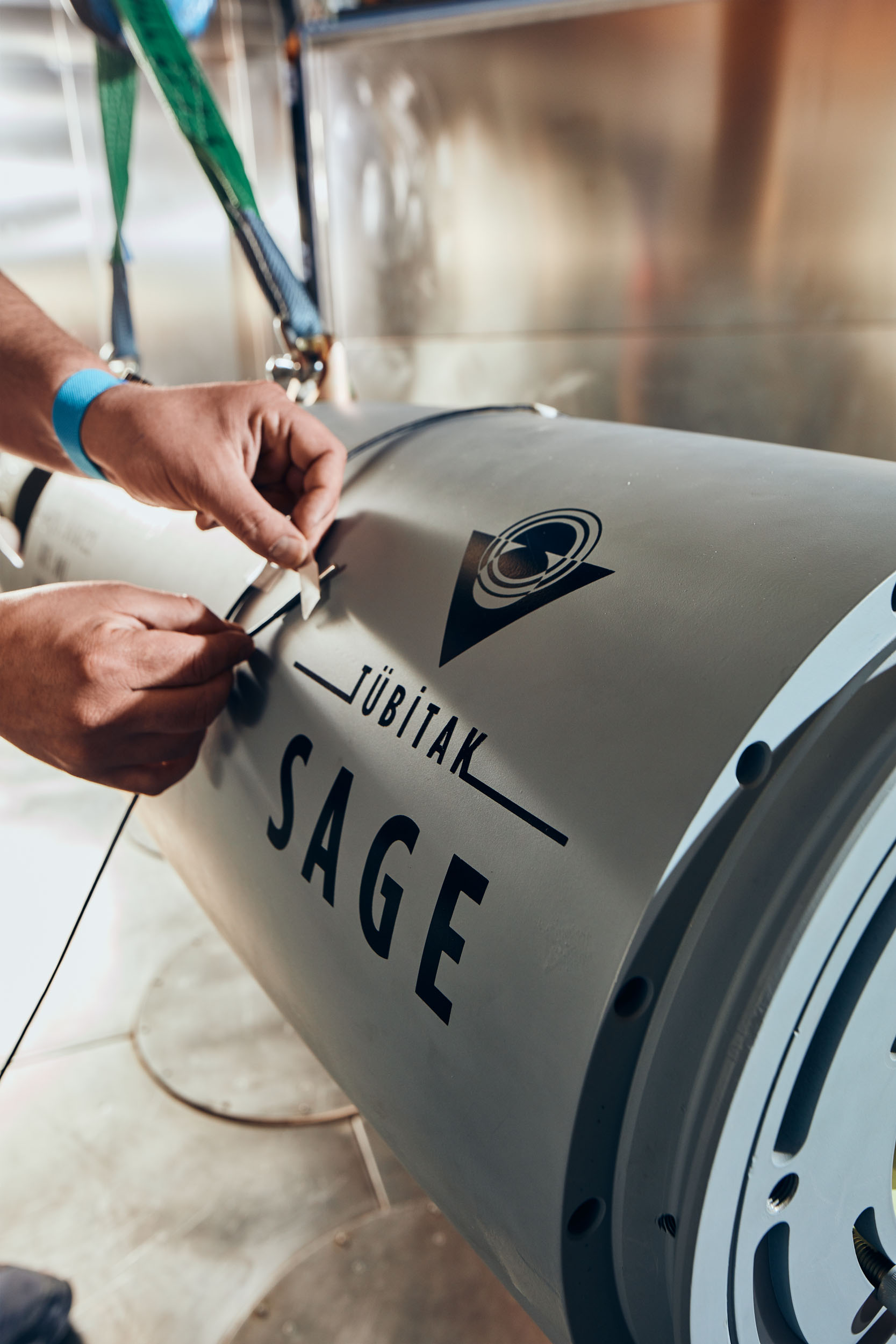
Temperature Shock Test is used to determine if test sample can withstand sudden changes in the temperature of the surrounding atmosphere without experiencing physical damage or deterioration in performance. After installation of the test sample into the test chamber, the temperature shock conditions are applied to the test sample by considering the real temperature shock conditions that the test sample will be exposed. Physical inspection and operational checkout of the test sample are performed during and/or after the test and any failure is recorded.
Tests can be conducted according to any military and civil standards which are appropriate with the test device’s technical specifications. Especially according to MIL-STD-810F/G Method 503, variety of tests was applied.
Technical Specifications
Technical specifications of five different test chambers are given below;
Climatic Test Chamber – I
- Dimensions (H x W x D): 2000 mm x 5500 mm x 2000 mm
- Sample weight: 3500 kg max.
- Temperature range: -60°C to +90°C
- Humidity range: 10% to 95% relative humidity
- Temperature accuracy: ±2°C
- Humidity accuracy: ±3 to 5 % relative humidity
Climatic Test Chamber - II
- Dimensions (H x W x D): 1000mm x 1000mm x 1000mm
- Sample weight: 250 kg max.
- Temperature range: -60°C to +150°C
- Humidity range: 10% to 98% relative humidity
- Temperature accuracy: ±1°C
- Humidity accuracy: ±3 to 5 % relative humidity
- ESS Test (temperature change rate more than 10°C/min.) capability
Climatic Test Chamber - III
- Dimensions (H x W x D): 900 mm x 1000 mm x 2000 mm
- Sample weight: 250 kg max.
- Temperature range: -60°C to +150°C
- Humidity range: 10% to 98% relative humidity
- Temperature accuracy: ±2°C
- Humidity accuracy: ±3 to 5 % relative humidity
Climatic Test Chamber – IV
- Dimensions (H x W x D): 1300 mm x 700 mm x 900 mm
- Sample weight: 150 kg max.
- Temperature range: -60°C to +150°C
- Temperature accuracy: ±1°C
- Temperature shock capability between hot and cold chambers by help of moveable basket (less than 1min. transfer time)
(Drive-In) Climatic Test Chamber (Not ready yet.)
- Dimensions (H x W x D): 5000 mm x 5000 mm x 10000 mm (There are two chambers with these dimensions.)
- Sample weight: 65000 kg max. (Moving trolley capacity 5000kg)
- Temperature range: -70°C to +90°C (1st. chamber) / -60°C to +125°C (2nd. chamber)
- Humidity range: 10% to 95% relative humidity
- Temperature accuracy: ±1°C
- Humidity accuracy: ±%4 relative humidity
- Exhaust outlet and conditioned fresh air intake for Hot/Cold Start of Engines
- Ability to perform thermal shock test between hot and cold chambers with the usage of movable trolley (within 1-minute max.)
The Solar Radiation Test is performed to determine heating and actinic (light induced decay) effects on the test sample due to solar radiation. The solar radiation conditions that it may encounter under real usage conditions are applied to the sample placed in the test chamber. Physical inspection and functional checkout of the test sample are performed during and/or at the end of the test and any failure is recorded.
Tests can be conducted according to any military and civil standards which are appropriate with the test device’s technical specifications.
Technical Specifications
Technical specifications of test device are given below;
(Drive-In) Solar Radiation Test Chamber (Not ready yet.)
- Dimensions (H x W x D): 4000 mm x 4000 mm x 10000 mm
- Impact Area (W x D) : 3000mm x 8000mm
- Sample weight: 65000 kg max. (Moving trolley capacity 5000kg)
- Irradiance range: 55W/m² to 1120W/m²
- Temperature range: -10°C to +60°C (Solar lamps off) / +10°C to +60°C (Solar lamps on)
- Humidity range: 10% to 95% relative humidity (Solar lamps off) / 10% to 60% relative humidity (Solar lamps on)
- Irradiance accuracy: ±4% or ±15W/m² (which is greater)
- Temperature accuracy: ±1°C
- Humidity accuracy: ±%4 relative humidity
- Exhaust outlet and conditioned fresh air intake for Hot/Cold Start of Engines
Rain Test is used to determine the following with respect to rain, water spray, or dripping water:
- The effectiveness of protective covers, cases, and seals in preventing the penetration of water into the materiel.
- The capability of the materiel to satisfy its performance requirements during and after exposure to water.
- Any physical deterioration of the materiel caused by the rain.
- The effectiveness of any water removal system.
- The effectiveness of protection offered to a packaged materiel.
After installation of the test sample into the test chamber, it is exposed to rainfall conditions by considering the real rainfall conditions that the test sample will be exposed. Physical inspection and operational checkout of the test sample are performed during and/or after the test and any failure is recorded.
Tests can be conducted according to any military and civil standards which are appropriate with the test device’s technical specifications. Especially according to MIL-STD-810F/G Method 506, variety of tests was applied.
Technical Specifications
Technical specifications of three different test chambers are listed below;
Rain Test Chamber - I
- Dimensions (H x W x D) : 2000 mm x 2000 mm x 5500 mm
- Sample Weight: 3500 kg max.
- Water Pressure: 276 kPa min.
Rain Test Chamber - II
- Dimensions (H x W x D): 1000 mm x 900 mm x 900 mm
- Sample weight: 500 kg max.
- Wind Velocity: 18 m/s
(Drive-In) Rain Test Chamber – III (Not ready yet.)
- Dimensions (H x W x D): 5000 mm x 5500 mm x 11000 mm
- Sample weight: 65000 kg max. (Moving trolley capacity 5000kg)
- Water Pressure: 276 kPa min.
- Exhaust outlet and fresh air intake for engines
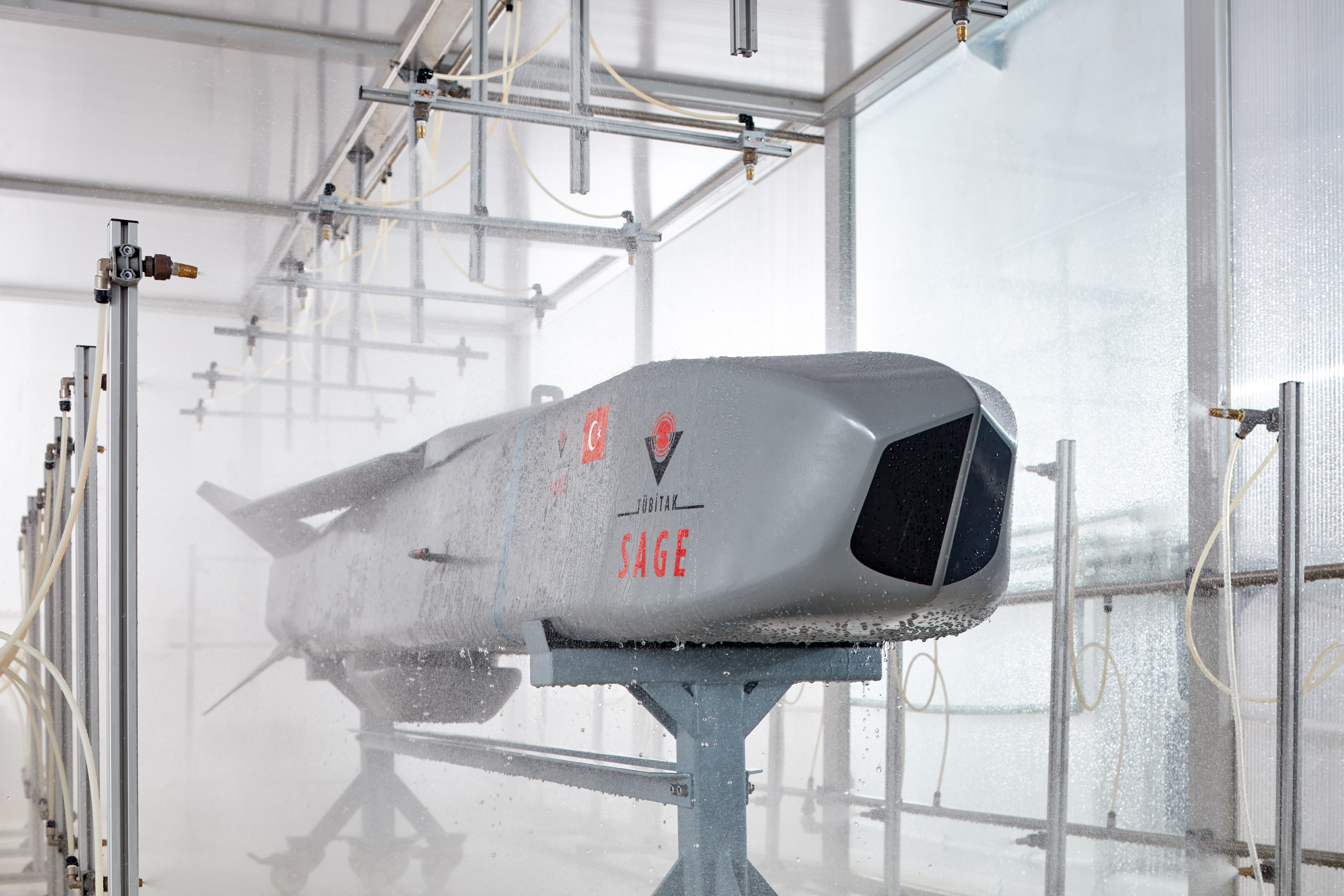
Humidity Test is used to determine the resistance of the test sample to the effects of a warm, humid atmosphere. After installation of the test sample into the test chamber, it is exposed to humid environment, which is appropriate to the usage and storage conditions of the sample, for an appropriate time interval. Physical inspection and operational checkout of the test sample are performed during and/or after the test and any failure is recorded.
Tests can be conducted according to any military and civil standards which are appropriate with the test device’s technical specifications. Especially according to MIL-STD-810F/G Method 507, variety of tests was applied.
Technical Specifications:
Technical specifications of three different test chambers are given below;
Climatic Test Chamber – I
- Dimensions (H x W x D): 2000 mm x 5500 mm x 2000 mm
- Sample weight: 3500 kg max.
- Operating temperature range: -60°C to +90°C
- Humidity range: 10% to 95% relative humidity
- Temperature accuracy: ±2°C
- Humidity accuracy: ±3 to 5 % relative humidity
Climatic Test Chamber - II
- Dimensions (H x W x D): 1000mm x 1000mm x 1000mm
- Sample weight: 250 kg max.
- Operating temperature range: -60°C to +150°C
- Humidity range: 10% to 98% relative humidity
- Temperature accuracy: ±1°C
- Humidity accuracy: ±3 to 5 % relative humidity
- ESS Test (temperature change rate more than 10°C/min.) capability
(Drive-In) Climatic Test Chamber (Not ready yet.)
- Dimensions (H x W x D): 5000 mm x 5000 mm x 10000 mm (There are two chambers with these dimensions. It can also be used as a single cabinet with dimensions of 5000mm x 5000mm x 20000mm.)
- Sample weight: 65000 kg max. (Moving trolley capacity 5000kg)
- Operating temperature range: -70°C to +90°C (1st. chamber) / -60°C to +125°C (2nd. chamber)
- Humidity range: 10% to 95% relative humidity
- Temperature accuracy: ±1°C
- Humidity accuracy: ±%4 relative humidity
- Exhaust outlet and conditioned fresh air intake for Hot/Cold Start of Engines
Salt Fog Test is used to determine the effectiveness of protective coatings and finishes on test samples and salt deposits on the physical and electrical aspects of test sample. After installation of the test sample into the test chamber, it is exposed to salt fog atmosphere. The physical, electrical checkout and the corrosion examination of the test sample are conducted after the test and any failure is recorded.
Tests can be conducted according to any military and civil standards which are appropriate with the test device’s technical specifications. Especially according to MIL-STD-810F/G Method 509, variety of tests was applied.
Technical Specifications:
Technical specifications of three different test chambers are given below;
Salt Fog Test Chamber - I
- Dimensions (H x W x D): 1200 mm x 3000 mm x 1300 mm
- Sample weight: 300 kg max.
- Operating temperature range: Ambient temperature to +35°C
- Temperature accuracy: ±2°C
Salt Fog Test Chamber - II
- Dimensions (H x W x D): 1000 mm x 1500 mm x 500 mm
- Sample weight: 220 kg max.
- Operating temperature range: Ambient temperature to +35°C
- Temperature accuracy: ±2°C
(Drive-In) Salt Fog Test Chamber (Not ready yet.)
- Dimensions (H x W x D): 3000mm x 3000mm x 10000mm
- Sample weight: 65000 kg max. (Moving trolley capacity 5000kg)
- Temperature range: +25°C to +50°C
- Humidity range: 40% to 55% relative humidity
- Temperature accuracy: ±1°C
- Humidity accuracy: ±%4 relative humidity
- Exhaust outlet and conditioned fresh air intake for Hot/Cold Start of Engines
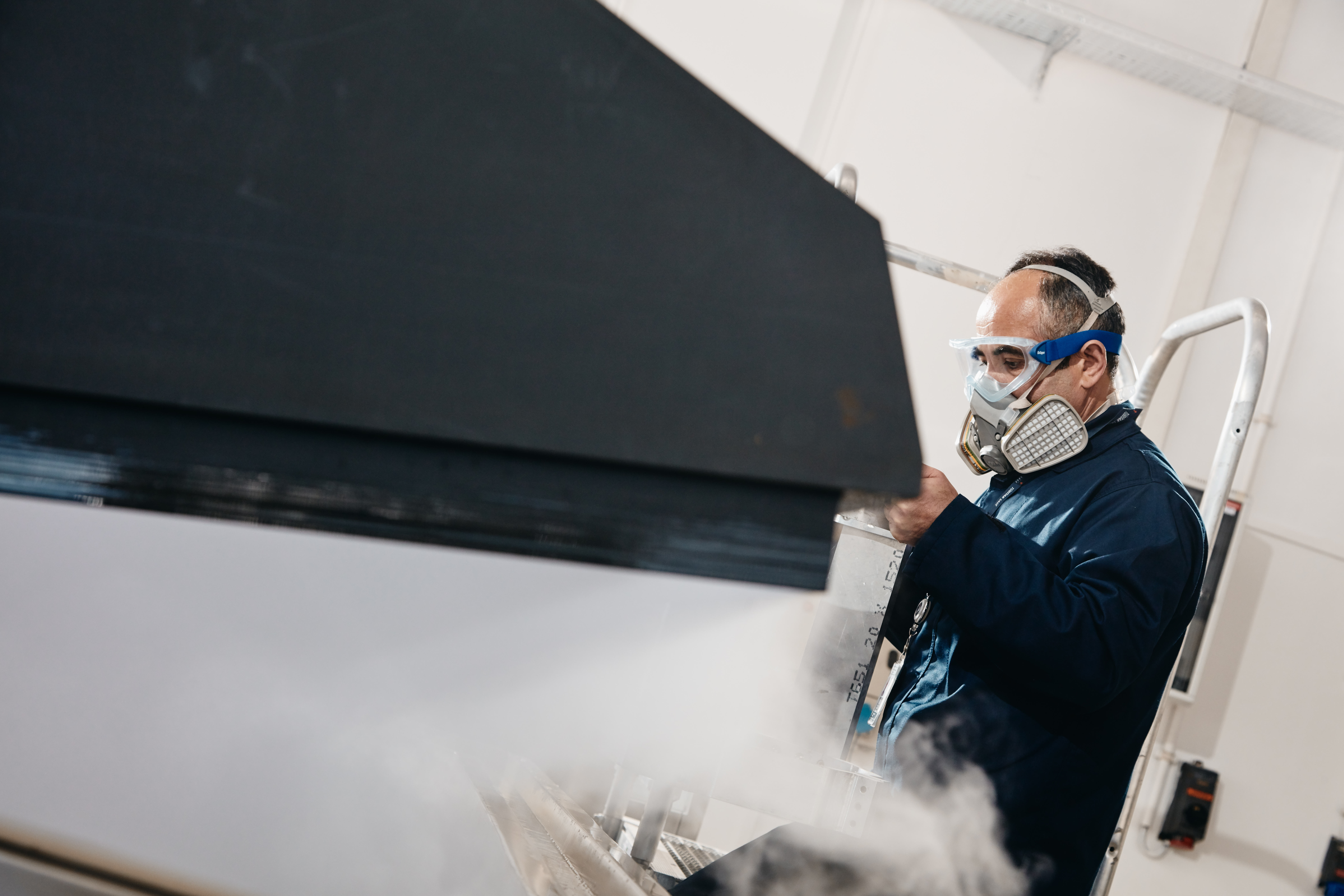
Sand and Dust Test is performed to examine the integrity and performance of test samples stored and/or used in sandy and dusty environments under these conditions.
The sand and dust conditions that it may encounter under real usage conditions are applied to the sample placed in the test chamber. Physical inspection and functional checkout of the test sample are performed during and/or at the end of the test and any failure is recorded.
Tests can be conducted according to any military and civil standards which are appropriate with the test device’s technical specifications.
Technical Specifications
Technical specifications of test device are given below;
Sand and Dust Test Chamber (Not ready yet.)
- Dimensions (H x W x D): 2200mm x 10000mm x 2200mm
- Sample weight: 5000 kg max.
- Temperature range: +20°C to +70°C
- Sand concentration range: 0.18g/cm³ to 2.7g/cm³
- Dust concentration range: 10.5g/cm³ ± 7g/cm³
- Air Velocity range: 1.5m/s to 18.5m/s
- Humidity range: ≤30%
- Temperature accuracy: ±1°C
Acceleration Test is used to assure that test sample can structurally withstand the steady state inertia loads that are induced by platform acceleration, deceleration, and maneuver in the service environment, and function without degradation during and following exposure to these forces. After installation of the test sample onto the test device, it is exposed to acceleration environment, which is appropriate to the usage and storage conditions of the sample, for an appropriate time interval. Physical inspection and operational checkout of the test sample are performed during and/or after the test and any failure is recorded.
Tests can be conducted according to any military and civil standards which are appropriate with the test device’s technical specifications. Especially according to MIL-STD-810F/G Method 513, variety of tests was applied.
Technical Specifications
Technical specifications of test device are given below;
Acceleration Test Device
- Acceleration Range: 3g ~ 100g
- 100g with 10kg load (Windward area < 0.1m2)
- 75g with 400kg load (Windward area < 1m2)
- 10g with 1000kg load
- Centrifuge Arm Radius: 4850mm
- Acceleration measurement possibility from the test sample
- Operational Checkout Possibility48 kanal elektriksel Slip-Ring bağlantısı
- 48 channels electrical Slip Ring connection
- 6 channels Fluid Rotary Joint (oil, fuel, compressed air, etc.) connection
- 3 channels Fiber Optic connection
- 1 channel Ethernet connection
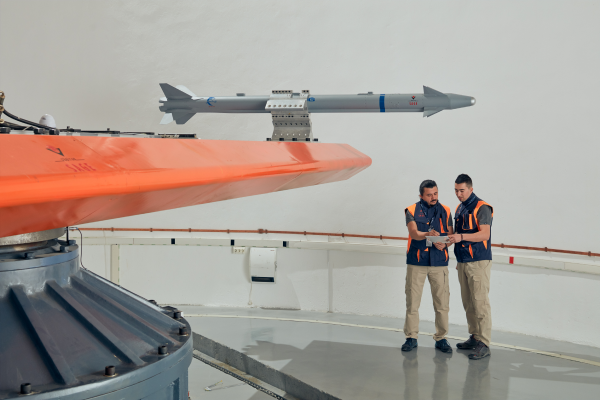
Vibration, Shock and Shipboard Material Mechanical Vibration Tests are used to determine effects of dynamic forces on the test sample safety, integrity and performance. The acceptability limits are determined by using civil/military standards or data acquisition under the most real operation environment. The dynamic forces are simulated in laboratory environment by using data acquisition systems, control systems, sensors, shakers and portable climatic chamber if needed. Physical inspection and operational checkout of the test sample are performed during and/or after the test and any failure is recorded.
Tests can be conducted according to any military and civil standards which are appropriate with the test device’s technical specifications. Especially according to MIL-STD-810F/G (Method 514, Method 516, Method 528) and MIL-STD-167-1/A (Type 1), variety of tests was applied.
Technical Specifications:
Technical specifications of three different vibration/shock test systems are given below;
Vibration/Shock Test System - I
- Random / Sine Peak Force: 70000 N
- Shock peak force: 140000 N
- Frequency range: 4-2000 Hz
- Maximum rated travel (pk-pk): 76 mm
- Maximum velocity (sine/random/shock): 2/2/3 m/s
- Maximum acceleration (sine/random/shock): 85/85/110 g
- Static load capacity: 1000 kg
- Slip Table Size: 1200 mm x 1200 mm
- Slip Table Load capacity: 10000 kg
Vibration/Shock Test System - II
- Random / Sine Peak Force: 20000 N
- Shock Peak Force: 40000 N
- Frequency range: 4-2000 Hz
- Maximum rated travel (pk-pk): 76 mm
- Maximum velocity (sine/random/shock): 2/2/3,5 m/s
- Maximum acceleration (sine/random/shock): 90/90/150 g
- Static load capacity: 300 kg
(Ex-Proof) Vibration/Shock Test System - III
- Random / Sine Peak Force: 200000 N
- Shock peak force: 400000 N
- Frequency range: 1-2000 Hz
- Maximum rated travel (pk-pk): 76 mm
- Maximum velocity (sine/random/shock): 2/2/2,5 m/s
- Maximum acceleration (sine/random/shock): 85/85/100 g
- Static load capacity: 2000 kg
- Slip Table Size: 1200 mm x 1750 mm
- Slip Table Load capacity: 10000 kg
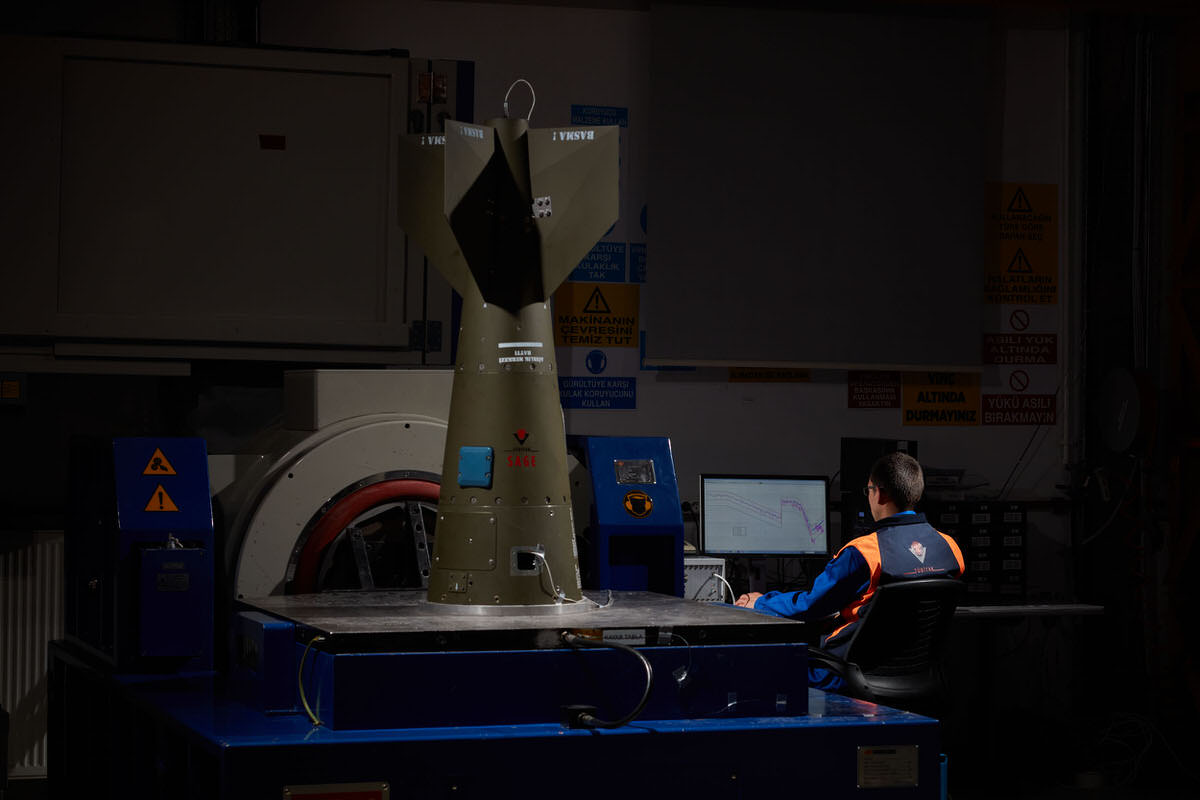
Drop Test is performed in order to examine the test sample in terms of structural integrity, safety and performance against drop situations that may occur during transportation, usage and bench handling operations. The sample is dropped over distances it might encounter under conditions of transport, usage and benchtop processing. At the end of the test, physical inspection of the sample and its functionality are checked, and any failures that occur are recorded. Drop Test can be performed in accordance with all military and civilian standards where technical capabilities are appropriate. Especially according to MIL-STD-810F/G Method 516 and MIL-STD-648D/E, variety of tests was applied.
The Icing / Freezing Rain Test is performed to determine the functional performance of the icing-induced test sample. The icing conditions that it may encounter under real usage conditions are applied to the sample placed in the test cabinet. Physical inspection and functional checkout of the test sample are performed during and/or at the end of the test and any failure is recorded.
Tests can be conducted according to any military and civil standards which are appropriate with the test device’s technical specifications.
Technical Specifications
Technical specifications of test device are given below;
(Drive-In) Icing/Freezing Rain Test Chamber (Not ready yet.)
- Dimensions (H x W x D): 4000mm x 4000mm x 10000mm
- Sample weight: 65000 kg max. (Moving trolley capacity 5000kg)
- Temperature range: -70°C to +80°C
- Temperature accuracy: ±1°C
- Ability to form ice thicknesses (6mm – 13mm – 37mm – 75mm)
- Exhaust outlet and conditioned fresh air intake for Hot/Cold Start of Engines
Electrostatic Discharge Test is performed in order to examine the integrity and performance of the test sample when exposed to personnel-induced electrostatic discharge. Electrostatic discharge conditions are applied to the test sample, which it may encounter under real usage conditions. During and/or at the end of the test, the physical inspection and functionality of the sample are checked, and any failures that occur are recorded.
Tests can be carried out in accordance with all military and civilian standards for which the technical features of the Electrostatic Discharge (ESB) device are suitable. Numerous tests have been carried out, especially in accordance with AECTP 500 Category 508 Leaflet 2 and IEC 61000-4-2 Part 4-2.
Technical Specifications
Technical specifications of test device are given below;
ESD Test Device
- Voltage range: 5kV to 30kV
- Capacitance: 500pF
- Series Resistance: 500Ohms and 5000Ohms
- Discharge Inductance: <5mH
Hydrostatic Pressure Test is performed in order to determine the resistance of pressure vessels against high pressure. A defined pressure is applied to the sample for a certain period of time. At the end of the test, the physical examination of the sample is made, and any failures that occur are recorded.
Tests can be conducted according to any military and civil standards which are appropriate with the test device’s technical specifications.
Technical Specifications
Technical specifications of test device are given below;
Hydrostatic Pressure Test Device
- Dimensions (H x W x D): 1500mm x 4000mm x 1250mm
- Pressure Range: 0 to 1000bar
- Pressurization Speed: 20bar/s. max.
- Pressure Accuracy: ±%3
- Fluid: Water
- Capable of recording images with 4 cameras placed in the test device for leakage control
Structural and Leakage Integrity Tests are performed to determine the effect of positive and negative pressure conditions that may occur inside the transport boxes and to verify that they meet the sealing requirements. The inside of the test sample is brought to defined positive and negative pressure values. In the Leakage Integrity Test, the amount of leakage at a certain time at the end of the pressurization process is measured. At the end of the test, the physical inspection of the test sample is made, and any failures that occur are recorded. Structural and Leakage Integrity Tests can be performed in accordance with all military and civilian standards where technical capabilities are appropriate. Numerous tests have been carried out, especially in accordance with MIL-STD-648D/E.
Mobile High and Low Temperature Tests are performed to determine the performance of the test sample in high and low temperature conditions in the usage environment. The test sample placed in the test chamber or in a separate insulated cabinet is kept for an appropriate period of time under high or low temperature conditions that it may encounter under real usage conditions. The conditioned test sample is removed from the cabinet and functionality is checked.
Tests can be conducted according to any military and civil standards which are appropriate with the test device’s technical specifications.
Technical Specifications
Technical specifications of two different test devices are given below
Portable Conditioning Test Device
- Dimensions (H x W x D): Can be made in any size
- Temperature range: -60°C to +150°C
- Temperature accuracy: ±2°C
Mobile Conditioning Vehicle (Not ready yet.)
- Dimensions (H x W x D): 1230mm x 1300mm x 4500mm
- Temperature range: -60°C to +90°C
- Temperature accuracy: ±2°C
Ability to condition externally insulated cabinet, which can be made in any size
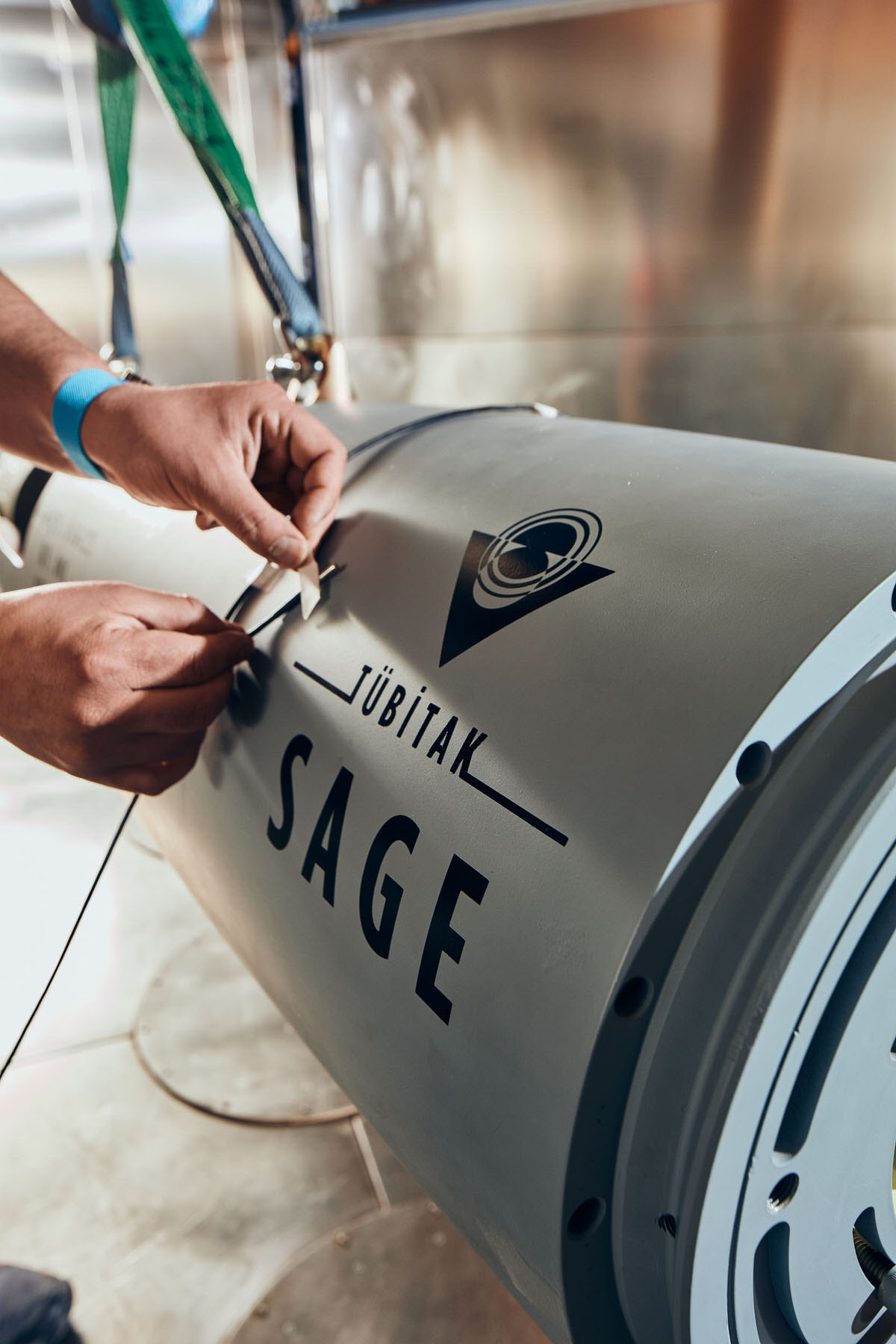
The Stacking Test is performed to determine the structural integrity of the transport boxes under the conditions of stacking on top of each other or different loadings on the sample. The required load is placed on the sample within the scope of the performance requirement of the test and it is kept for a defined period of time. This test can be performed under certain temperature and relative humidity conditions if it is required in a suitable climatic chamber. At the end of the test, the physical inspection of the sample is made, and any failures that occur are recorded. The Stacking Test can be performed in accordance with all military and civilian standards where technical capabilities are appropriate. Numerous tests have been carried out, especially in accordance with MIL-STD-648D/E.
